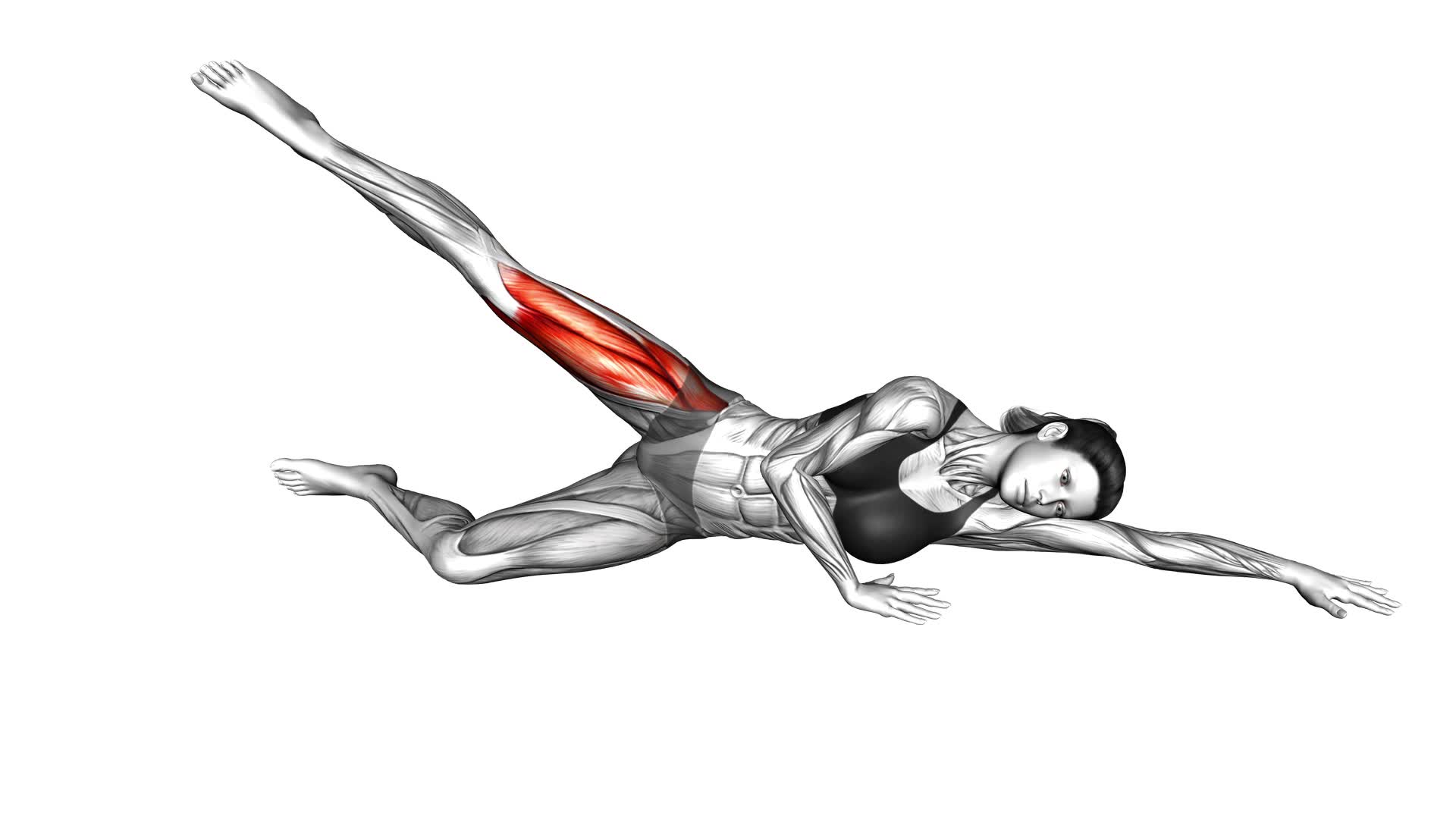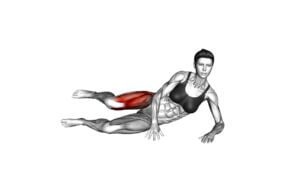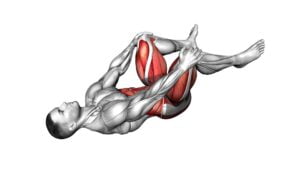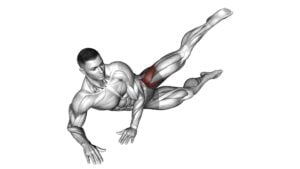Side Lying Hip Circle (female) – Video Exercise Guide & Tips

Get ready to tone and strengthen your hips with the side lying hip circle. In this video exercise guide, we'll show you step-by-step how to perform this effective move.
Watch This Exercise Video
You'll discover the benefits of incorporating the side lying hip circle into your routine and learn common mistakes to avoid.
Plus, we'll share tips for maximizing its effectiveness and offer modifications and variations to challenge yourself further.
Let's get started and transform your hips with this dynamic exercise.
Key Takeaways
- The side lying hip circle exercise improves hip mobility and strengthens the glutes.
- Using equipment such as resistance bands, stability balls, and foam rollers enhances the effectiveness of the exercise.
- There are various modifications and variations of the exercise that can target different muscle groups and provide progressive overload.
- Engaging core muscles is important for stability and to prevent strain on the lower back.
Benefits of the Side Lying Hip Circle
Discover the numerous benefits of the Side Lying Hip Circle for improving hip mobility and strengthening the glutes.
The side lying hip circle is a versatile exercise that offers various variations to target different muscle groups and challenge your body in unique ways.
One of the main advantages of this exercise is its ability to improve hip mobility. By performing the hip circle movement, you're actively engaging the muscles around your hips and increasing their range of motion. This can be especially beneficial for individuals who've tight hips or suffer from hip pain.
Additionally, the side lying hip circle helps to strengthen the glutes, which are essential for stabilizing the hips and supporting overall lower body strength. By incorporating different variations into your routine, such as using resistance bands or adding a leg lift, you can further enhance the effectiveness of this exercise.
Now that you understand the importance of hip mobility and the benefits of the side lying hip circle, let's move on to the equipment needed for this exercise.
Equipment Needed for the Exercise
Before you begin the Side Lying Hip Circle exercise, it's important to have the right equipment.
The required equipment for this exercise includes a yoga mat or soft surface to lie on, and a resistance band.
If you don't have a resistance band, you can use a towel or a long scarf as an alternative.
Using the proper equipment will help you maximize the benefits of this exercise by providing resistance and stability.
Required Equipment for Exercise
To perform the Side Lying Hip Circle exercise, you'll need the following equipment: none. This exercise falls under the category of exercises without equipment, making it a convenient and accessible option for anyone looking to strengthen their hips and improve their overall fitness.
Bodyweight exercises, like the Side Lying Hip Circle, offer numerous benefits. They allow you to work on stability, mobility, and strength without the need for expensive equipment or a gym membership. Additionally, bodyweight exercises engage multiple muscle groups simultaneously, helping to improve coordination and balance.
Alternatives to Equipment
If you don't have any equipment, there are still alternatives available for the Side Lying Hip Circle exercise. You can perform bodyweight exercises that target the same muscle groups and provide similar benefits. For example, you can try clamshells, which also engage the hip abductors and glutes.
To do clamshells, lie on your side with your knees bent and feet together. Keeping your feet touching, lift your top knee as high as you can without moving your pelvis.
Another alternative is the fire hydrant exercise, where you start on all fours and lift your leg out to the side, mimicking a dog peeing on a fire hydrant.
These bodyweight exercises can be incorporated into your home workouts to effectively work your hips and glutes. However, using equipment can provide additional benefits, such as added resistance or stability, which we'll discuss next.
Benefits of Using Equipment
Using equipment for the Side Lying Hip Circle exercise allows you to enhance your workout routine and engage specific muscle groups more effectively. Here are some benefits of incorporating equipment into your exercise:
- Increased resistance: Using resistance bands or ankle weights can add resistance to the exercise, making it more challenging and increasing the strength and tone of your hip muscles.
- Improved stability: Equipment like stability balls or foam rollers can help improve your balance and stability while performing the exercise, engaging your core muscles to maintain proper form.
- Variety of options: With equipment, you have the option to modify the exercise and target different muscle groups. For example, using a resistance band can also engage your glutes and hamstrings.
- Enhanced muscle activation: Equipment can help activate and isolate specific muscles, allowing you to focus on strengthening and toning those areas.
- Progressive overload: By gradually increasing the resistance or difficulty level of the equipment, you can progressively challenge your muscles, leading to continuous improvement and development.
Step-By-Step Guide to Performing the Side Lying Hip Circle
Begin by lying on your side with your legs straight and your head supported on your arm. This is the starting position for the side lying hip circle exercise. To ensure proper form, make sure your body is in a straight line from head to toe. Your top hand can rest on the floor in front of you for added stability.
To perform the side lying hip circle, initiate the movement by lifting your top leg slightly off the ground. Keep your foot flexed and your toes pointing forward. Begin to trace a circle with your top leg, moving it forward, up, back, and down. As you complete the circle, focus on engaging your hip muscles and maintaining control throughout the movement.
Common errors to avoid include lifting the leg too high or swinging it too forcefully. Remember, this exercise is about controlled movements and engaging the muscles, not about speed or height. Also, be mindful of keeping your core engaged and your hips stable throughout the exercise. This will help prevent any unnecessary strain on your lower back.
Common Mistakes to Avoid During the Exercise
To perform the side lying hip circle exercise correctly, it's important to maintain proper hip alignment throughout the movement. This means keeping your hips stacked on top of each other and avoiding any tilting or rotating.
Additionally, engaging your core muscles is crucial for stability and control during the exercise. By avoiding these common mistakes, you can maximize the effectiveness and safety of the side lying hip circle.
Proper Hip Alignment
Maintain proper hip alignment throughout the exercise by focusing on your positioning. Proper hip alignment is crucial for effective hip mobility and to ensure that you're performing the exercise correctly. Here are five common mistakes to avoid when it comes to hip alignment:
- Keep your top hip stacked directly on top of your bottom hip.
- Avoid allowing your top hip to roll forward or backward.
- Keep your knees and ankles in line with your hips.
- Make sure your spine is straight and aligned with your hips.
- Avoid excessive twisting or tilting of your pelvis.
By following these tips, you can ensure that your hips are properly aligned throughout the exercise, which will help you maximize the benefits and prevent any potential injuries.
Now, let's move on to the next section about engaging your core muscles.
Engaging Core Muscles
Engage your core muscles to maintain stability and support throughout the exercise. Proper hip alignment is crucial to ensure effective and safe movement. By engaging your core muscles, you create a strong and stable foundation for the exercise. This helps to prevent any unnecessary strain on your lower back and promotes proper form.
To engage your core, imagine drawing your belly button in towards your spine, activating your deep abdominal muscles. Avoid relying solely on your hip muscles to perform the movement, as this can put excessive stress on the joints. Instead, focus on maintaining a neutral spine and using your core to control the movement.
Remember to breathe deeply and engage your core throughout the entire exercise for optimal results.
Tips for Maximizing the Effectiveness of the Side Lying Hip Circle
For maximum effectiveness of the Side Lying Hip Circle, focus on proper form and controlled movements. Here are some tips to help you maximize the results of this exercise and avoid common misconceptions:
- Engage your core: It's important to activate your core muscles throughout the entire movement. This will help stabilize your body and prevent any unnecessary strain on your lower back.
- Maintain proper alignment: Keep your body in a straight line from head to toe. Avoid letting your hips sag or rotate forward, as this can decrease the effectiveness of the exercise.
- Control the movement: Slow and controlled movements are key. Avoid swinging your leg or rushing through the exercise. Focus on feeling the muscles in your hips and glutes working with each repetition.
- Breathe: Remember to breathe throughout the exercise. Inhale as you prepare for the movement, and exhale as you perform the hip circle. This will help you maintain control and stability.
- Start with lighter resistance: If you're using a resistance band, start with a lighter band and gradually increase the resistance as you get stronger. This will ensure that you're able to maintain proper form and maximize the effectiveness of the exercise.
By following these tips, you can ensure that you're performing the Side Lying Hip Circle correctly and maximizing its effectiveness.
Now, let's move on to modifications and variations to challenge yourself further.
Modifications and Variations to Challenge Yourself Further
To challenge yourself further, try incorporating modifications and advanced variations into your Side Lying Hip Circle routine. These modifications and variations can help you target different muscles, increase the difficulty level, and keep your workouts interesting and effective.
One modification you can try is adding resistance. You can use a resistance band around your thighs or ankles to make the exercise more challenging. This will engage your muscles even more and increase the intensity of the movement.
Another modification is to use a stability ball. Place the ball between your knees or ankles and perform the hip circles. This will require more stability and core strength, giving you an extra challenge.
If you're looking for advanced variations, you can try lifting your top leg while performing the hip circles. This will engage your glutes and outer thigh muscles even more.
Another variation is to perform the hip circles with ankle weights. This will add resistance and make the exercise more challenging for your hip muscles.
Remember to always listen to your body and start with modifications that are suitable for your fitness level. As you get stronger and more comfortable, you can gradually increase the difficulty level by incorporating advanced variations into your Side Lying Hip Circle routine.
Frequently Asked Questions
How Many Repetitions of the Side Lying Hip Circle Should I Do in One Session?
For maximum results, the optimal number of repetitions for the side lying hip circle can vary depending on your fitness level. It's recommended to start with 10 to 12 repetitions per session.
As you progress, you can gradually increase the number of repetitions. However, it's important to listen to your body and not push yourself too hard.
If you're a beginner, you can modify the exercise by performing smaller circles or reducing the number of repetitions.
Can Men Also Benefit From Doing the Side Lying Hip Circle Exercise?
Yes, men can definitely benefit from doing the side lying hip circle exercise. It helps to strengthen the hip muscles and improve overall stability, which is important for men's fitness.
However, if you're looking for alternative exercises, you can also try exercises like the clamshell or the glute bridge. These exercises target similar muscle groups and can be beneficial for men as well.
Remember to consult with a fitness professional for personalized advice.
Is It Normal to Feel a Burning Sensation in the Hip Muscles While Performing This Exercise?
Feeling a burning sensation in your hip muscles during the side lying hip circle exercise is quite normal. This sensation is a sign that your hip muscles are being activated and challenged. It indicates that you're working the muscles effectively and building strength.
However, if the burning sensation becomes too intense or painful, it's important to listen to your body and modify the exercise or consult a fitness professional to ensure proper form and technique.
Can the Side Lying Hip Circle Help With Improving Flexibility and Range of Motion?
Improving hip flexibility and increasing hip range of motion can be achieved through the side lying hip circle exercise.
By engaging the muscles around your hip joint, this exercise helps to stretch and strengthen the hip muscles, allowing for greater flexibility and a wider range of motion.
Performing the side lying hip circle regularly can gradually improve your hip mobility, making everyday movements easier and reducing the risk of hip-related injuries.
Are There Any Specific Breathing Techniques That Should Be Followed While Doing This Exercise?
To maximize the benefits of the side lying hip circle, it's important to focus on your breathing technique. By taking deep breaths in and out throughout the exercise, you can help oxygenate your muscles and improve your overall performance.
Additionally, proper breathing can aid in maintaining stability and control during the movement. So, remember to inhale and exhale smoothly and rhythmically as you engage in the side lying hip circle.
This technique applies to both men and women.
Conclusion
The side lying hip circle is a beneficial exercise that targets the hips and glutes. It can be performed with minimal equipment and is easy to follow with our step-by-step guide. By avoiding common mistakes and following our tips, you can maximize the effectiveness of this exercise.
Additionally, there are modifications and variations available to challenge yourself further. Incorporate the side lying hip circle into your workout routine for improved hip strength and stability.

Author
Years ago, the spark of my life’s passion ignited in my mind the moment I stepped into the local gym for the first time. The inaugural bead of perspiration, the initial endeavor, the very first surge of endorphins, and a sense of pride that washed over me post-workout marked the beginning of my deep-seated interest in strength sports, fitness, and sports nutrition. This very curiosity blossomed rapidly into a profound fascination, propelling me to earn a Master’s degree in Physical Education from the Academy of Physical Education in Krakow, followed by a Sports Manager diploma from the Jagiellonian University. My journey of growth led me to gain more specialized qualifications, such as being a certified personal trainer with a focus on sports dietetics, a lifeguard, and an instructor for wellness and corrective gymnastics. Theoretical knowledge paired seamlessly with practical experience, reinforcing my belief that the transformation of individuals under my guidance was also a reflection of my personal growth. This belief holds true even today. Each day, I strive to push the boundaries and explore new realms. These realms gently elevate me to greater heights. The unique combination of passion for my field and the continuous quest for growth fuels my drive to break new ground.



